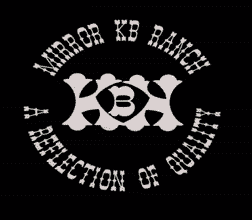 |
Mirror KB Articles
|
 |
Mirror KB Articles
|
Mirror KB Appaloosa Ranch & Photography Equine Article Series
Environmental Teratogens:
And their Effect on the Unborn Foal
by Kim and Kari Baker
If you’ve spent any time around a breeding farm or stable swapping stories and breeding tips, you know the talk will at some point turn to birth abnormalities, with much of the discussion centering around genetic causes and who to breed to and who not.
It begins to sound as if nearly every defect can be blamed on the mare, the stallion or both. The reality is, only about 15 percent of all birth defects are proven genetic. Environmental influences that cause approximately 5 percent of all congenital defects have been identified with the balance of roughly 80 percent caused by environmental or genetic-environmental interactions of unknown factors.
Genetic messages do initiate and monitor the growth and differentiation of the embryonic cell, but this important developmental process can be influenced by environmental factors. The environment, that is the fetus’ environment, is protected by 6 layers of tissue that make up the placenta. The theory that the placenta provides an effective barrier to harmful substances is only partly true. The placenta does have the capability to screen out many injurious substances on the basis of size, but countless teratogens such as disease-causing organisms and chemicals are small enough to readily cross the barrier and enter the developing fetus. In general, molecules small enough to pass through the gastrointestinal tract will also be able to cross the placental barrier.
Environmental teratogens, defined as any agent or substance that is capable of interfering with the development of a fetus causing birth defects or death of the fetus, include vitamin and mineral deficiencies or imbalances, numerous therapeutic drugs, chemicals such as herbicides and pesticides, noxious plants and viral and bacterial infections. The impact a teratogen will have on the fetus depends on several factors. The type of agent involved may determine the area of body or which developmental process will be affected. If several substances are involved, their relationship may also have a significant effect on the type of abnormality that results.
Timing is also a factor. The stage of development is critical in determining the severity of an agent or substance’s actions. A toxic agent present at the earliest state may alter the transport of the fertilized ovum in the oviducts or affect mobility of the ovum within the uterus, impairing implantation resulting in early embryonic death.
Most developmental abnormalities occur during early pregnancy when cells are differentiating to form specialized body structures. During this time of extreme vulnerability, teratogens damage the cells by arresting cell growth or by changing their normal growth patterns for a particular area. Growth and differentiation is a continuous process with the periods of susceptibility of different organs or tissues difficult to pin point. As the pregnancy progresses, the susceptibility of the fetus to various agents changes, with the developing systems becoming functionally rather than structurally damaged. While structural defects are generally obvious soon after parturition, many functional impairments may not be evident until several days, weeks or even years after birth.
The mare is capable of breaking down some teratogens so the level of exposure to the fetus is reduced, but if the mare’s liver or kidney function is impaired, prolonged fetal exposure will result due to the mare’s inability to eliminate the agent from her own circulatory system. Even in a healthy mare, the placental/nutrient exchange system is unable to remove blood-borne teratogens from the fetal circulation system efficiently. Because the fetal liver is unable to detoxify blood until after birth, teratogens that do pass through the placental barrier may become concentrated in the fetal tissues as gestation progresses.
Keeping the mare healthy is of primary consideration during her pregnancy, but the use of common drugs administered to treat pregnant mares have a decisive outcome on the welfare of their foals. Any medication given to the mare during pregnancy should be dispensed cautiously and others restricted altogether. Choose medications that have been proven safe for pregnant mares. Those drugs which indicate “No information for use in broodmares is available” on the label, are not to be considered safe. It is the best policy to exclude the use of any drug unless there is a clear clinical indication for its use and those that must be introduced should be dispensed for the shortest time possible. In all situations, analyze the relative risks and benefits before giving drugs.
Little is known about the actions of most drugs, chemicals and other toxic agents on the fetus. Many complicating factors may produce totally different effects, such as the combination of the agents or the length of exposure. Keep in mind that any agent that can have a detrimental effect on the well being of the mare or the specific health of her reproductive system at any state of pregnancy will have a direct effect on fetal development and survival.
If you'd like to read more interesting articles click on the following
drop down link:
|
Mirror KB Photography & Gifts 1132 Arabian Lane Libby, MT 59923-7982 |
Phone: (406) 293-6586 |
Got questions? Email us at wranglers@mirrorkbranch.com
Trailhead | About
Us
| On the Trail | Raising an Orphan Filly
| Tales of the Twin Wranglers
Gallery 1 | Gallery
2 | Gallery 3 | Gallery
4 | Gallery 5
Montana T-shirts and more | Clothes an' more with Robert Fuller
Design
your own | Product
Information
Training Philosophy | Photography
| Promotional Photography
Gallery 6 | Gallery
7 | Gallery 8
| Gallery 9 | Gallery
10 | Gallery 11
Just Text Horse T-shirts | Just Text Mule T-shirts
Equine Articles | Twin
Wranglers | Ol' Bake
Equine
Hangman | Product
Order Form | Links
Our
Privacy Policy
Send an
E-greeting | order Greeting Cards